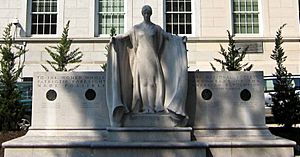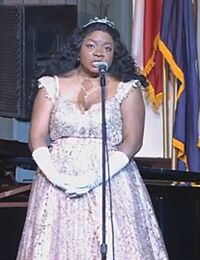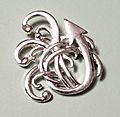Daughters of the American Revolution facts for kids
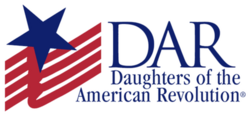 |
|
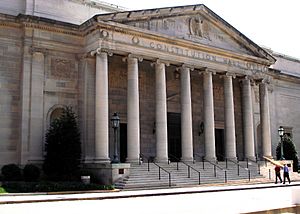
|
|
| Abbreviation | NSDAR or DAR |
|---|---|
| Founded | October 11, 1890 |
| Founders | Mary Smith Lockwood Mary Desha Ellen Hardin Walworth Eugenia Washington |
| Founded at | Strathmore Arms 810 12th Street NW Washington, D.C., U.S. |
| Type | Non-profit, lineage society, service organization |
| Focus | Historic preservation, education, patriotism, community service |
| Headquarters | Memorial Continental Hall 1776 D Street NW Washington, D.C., U.S. |
|
Membership
|
190,000 |
|
President General
|
Ginnie Sebastian Storage |
| Publication | American Monthly (1892–2001) American Spirit Magazine (2001–present) Daughters Magazine (2001–present) |
| Affiliations | Children of the American Revolution |
The National Society Daughters of the American Revolution, often called the DAR, is a service organization for women. To join, a woman must be a direct descendant of a patriot who helped the United States win its independence during the American Revolution. A patriot could be a soldier or anyone else who supported the cause.
The DAR is a non-profit group that focuses on preserving history, promoting education, and encouraging patriotism. It has over 190,000 members in the United States and other countries. To join, a woman must be at least 18 years old. The group's motto is "God, Home, and Country."
Contents
How the DAR Began
In the late 1800s, many Americans became very interested in their country's history. This led to the creation of many patriotic groups. One of these groups was the Sons of the American Revolution. However, they did not allow women to join.
In 1890, a woman named Mary Smith Lockwood wrote an article in The Washington Post. She told the story of Hannah White Arnett, a woman who was a patriot during the Revolution. Lockwood asked why there wasn't a group for the daughters of patriots. Soon after, a man named William O. McDowell offered to help start a group called the Daughters of the American Revolution.
The first official meeting was held on October 11, 1890. The four main founders were Mary Smith Lockwood, Eugenia Washington (a great-grandniece of George Washington), Ellen Hardin Walworth, and Mary Desha.
The wife of President Benjamin Harrison, Caroline Lavina Scott Harrison, became the first leader, or President General, of the DAR. She was very interested in history and helped set the goals for the organization.
What the DAR Does
The DAR is very active in communities across the country. Its work is divided into a few main areas.
Preserving History
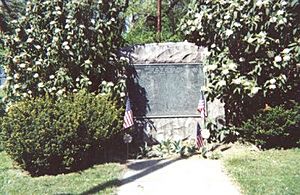
From the beginning, DAR chapters have worked to save history. They raised money to place markers on the graves of soldiers from the Revolutionary War. They also put up monuments at important battle sites.
The DAR wanted to honor the women who were patriots, not just the male soldiers. For example, they placed a monument at a spring where women carried water to put out fires during an attack at Bryan Station in Kentucky. Chapters also bought and now take care of historic houses and other important sites from the war.
Helping the Community
DAR members volunteer their time to help others. They spend thousands of hours each year helping veterans at hospitals. They also send care packages and other items to American soldiers serving in other countries.
The group sponsors special programs to teach people about the U.S. Constitution. Members also take part in ceremonies where people officially become U.S. citizens.
Promoting Education
The DAR supports education in many ways. It gives over $1 million each year to five special schools that help students with different needs. The organization also provides scholarships to students going to college.
Each year, the DAR holds an American history essay contest for students in 5th through 8th grade. Winners can receive money for their education. The group also works to promote literacy for both children and adults.
Who Can Join the DAR?
To become a member of the DAR, a woman must be 18 or older. She must be able to prove that she is a direct descendant of a patriot of the American Revolution. This means one of her ancestors must have helped the United States become an independent country.
A patriot could be someone who:
- Signed the United States Declaration of Independence.
- Fought in the American Revolutionary War.
- Served in the government during the Revolution.
- Signed an oath of loyalty to the new country.
- Participated in the Boston Tea Party.
- Helped as a doctor, nurse, or minister.
- Gave supplies or other support to the cause.
The DAR welcomes women of all races and religions. The organization has a large genealogical library and online tools to help people research their family history and find out if they have a patriot ancestor.
Diversity and Important Events
Over the years, the DAR has faced challenges and made important changes.
The Marian Anderson Controversy
In the 1930s, Washington, D.C., was a racially segregated city. This meant that Black people and white people were often kept separate in public places. In 1932, the DAR made a rule that Black musicians could not perform in its concert hall, DAR Constitution Hall.
In 1939, the DAR refused to let Marian Anderson, a famous and talented African American singer, perform at the hall. This caused a major controversy. First Lady Eleanor Roosevelt, who was a DAR member, resigned from the group to protest the decision.
With help from the Roosevelts, Marian Anderson instead held a free outdoor concert on the steps of the Lincoln Memorial. More than 75,000 people came to listen, and millions more heard it on the radio. This event became a powerful moment in the fight for civil rights. In 1952, the DAR changed its policy and began allowing performers of all races in its hall.
Welcoming All Women
The DAR has worked to become a more inclusive organization. In 1977, Karen Batchelor Farmer became the first known African American member of the DAR.
In the 1980s, another Black woman named Lena Santos Ferguson was at first denied membership. This led to public outcry and caused the DAR to change its rules to officially ban discrimination based on race. The DAR also began a project to find and honor the thousands of African American and Native American patriots who fought in the Revolution.
Today, the DAR continues to welcome women from all backgrounds. In recent years, the first Black women have been elected to state and national leadership positions within the organization.
Notable Members
Many famous and important women have been members of the DAR. These include six First Ladies of the United States: Caroline Harrison, Eleanor Roosevelt, Rosalynn Carter, Barbara Bush, and Laura Bush.
Other well-known members include U.S. Senator Tammy Duckworth, actress Ginger Rogers, and computer scientist Rear Admiral Grace Hopper. Many governors, members of Congress, and military officers have also been part of the DAR.
Images for kids
See also
 In Spanish: Daughters of the American Revolution para niños
In Spanish: Daughters of the American Revolution para niños
- Children of the American Revolution
- Colonial Dames of America
- Society of the Cincinnati
- Sons of the American Revolution
- Sons of the Revolution


